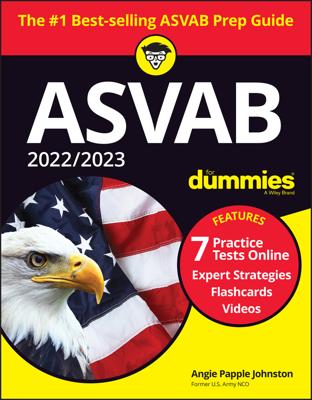On the ASVAB, guessing is okay. In fact, it’s encouraged — but within reason. Guessing is encouraged because of how the test is scored. Here’s how the point system breaks down:
If you choose the correct answer, you get one point (or more, depending on how the question is weighted).
If you don’t answer a question, you get nada.
If you guess on a question and get the question wrong, you get nada — no worrying about losing points or getting any sort of penalty!
You should try not to guess your way through a bunch of questions at the end of a subtest if you’re taking the CAT-ASVAB. You’re likely to do this when time is running out. If you answer a bunch of questions incorrectly at the end of a subtest, you may be penalized for mismanaging your time, and that penalty can hurt your score.
Because most questions have four possible answers, you generally have a 25 percent chance of guessing correctly, which means that you have chances to increase your score by guessing. Here are some guessing tips:
There’s always at least one answer that isn’t even close to the correct answer. By using simple deduction, you can often narrow your choices down to two answers or fewer.
Don’t eliminate an answer based on how frequently that answer comes up. For example, if Choice (B) has been the correct answer for the last five questions, don’t assume that it must be the wrong answer for the question you’re on just because that would make it six in a row.
Usually, an answer that has always, all, everyone, never, none, or no one is incorrect.
The longer the answer, the more likely that it’s the correct answer. The test-makers have to get all those qualifiers in there so you can’t find an example to contradict the correct answer. If you see phrases like “in many cases” or “frequently,” that’s a clue that the test-makers are trying to make the answer most correct.
If two choices are very similar in meaning, neither of them is probably the correct choice. On the other hand, if two answer options contradict each other, one of them is usually correct.
Don’t change an answer after you select it. If you have to guess, never, ever go back and change the answer, unless you’re absolutely, 100 percent, positively convinced that you’re changing it to the correct answer and you only answered incorrectly because you had sweat in your eyes and didn’t read the choices properly.
The United States Air Force Senior NCO Academy conducted an in-depth study of several Air Force multiple-choice test results, taken over several years, and found that when students changed answers on their answer sheets, they changed from a right answer to a wrong answer more than 72 percent of the time!
If you guess on more than one question throughout the test, choosing the same answer for every guess is a smart way to go. For example, all your guesses could be Choice (B). This technique slightly increases your chances of getting more answers correct. However, if you can eliminate Choice (B) as a wrong answer, then, by all means, choose a different answer option for that question.

